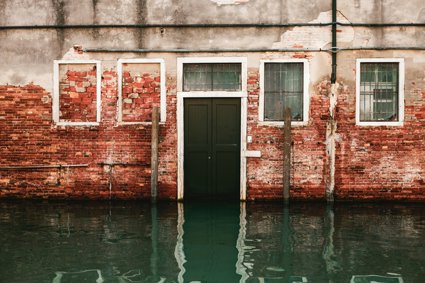
Flood proof homes
This lesson discusses the range of measures that are available to help families build up their own levels of flood resilience
Key questions
What measures are available to help families build up their own levels of flood resilience?
How do humans adapt to risk?
What measures are available to help families build up their own levels of flood resilience?
Measures can be used to make your home both resistant and resilient to flooding. Flood resistance measures add extra protection, preventing water from entering the home. Products for flood resistance include:
-
Pump and sump systems, which pump out water entering the house from the ground
-
Flood skirts or barriers, which protect any possible inlet for water,for example windows and doors, and are drawn into position when there's a threat of flooding
-
One-way valves, which prevent water backing up into the property from water outlet pipes
-
Water resistant sealants, which are used around windows and doors and on porous materials such as bricks and water
Measures to make your house more flood resilient, on the other hand, aim to minimise the damage caused by flood water. These include:
-
Replacing perishable materials, for example replacing chipboard floors for concrete and swapping carpet for tiles
-
Moving expensive electrical equipment out of the way, for example putting your boiler upstairs
-
Raising electrical points above likely flood levels
-
Replacing chipboard with plastic, for example fixtures and fittings in the kitchen and bathroom
-
Replacing wooden frames and skirting boards with plastic alternatives
-
Raising floor levels - of course this is not always possible
-
Replacing insulation from mineral to cell
-
Protecting joists with a chemical damp proof course
Families who live in flood risk areas should also consider preparing a flood kit. This should include the following items:
-
Important documents, such as passports and insurance certificates, which can be expensive to replace
-
A torch, in case the flood occurs at night and the power is affected
-
A battery or wind-up radio to listen for important information
-
A mobile phone to call for help
-
Waterproof clothing, for example wellies and rubber gloves in case you have to enter the flood water
-
A first aid kit to attend to any minor injuries
-
Blankets to keep you warm if your heating has to be switched off
-
Bottled water, as tap water won't be drinkable after a flood
-
Non-perishable items of food in case you are not able to be rescued for several hours
More information is available on the Scottish Environment Protection Agency website.
How do humans adapt to risk?
Other natural hazards include:
-
Volcanoes: can kill when they explode or through lava, pyroclastic flows, hot ash and poisonous gases. People often live near volcanoes due to the fertile soils found there, creating a hazard risk. Areas affected include South America's west coast
-
Hurricanes: can kill when strong winds destroy buildings and blow down trees and structures. They develop offshore in warm ocean regions. Areas affected by hurricanes are highly populated due to their location and climate, creating a hazard risk. Areas affected include the Caribbean and Florida
-
Droughts: can kill when water supplies are low, when crops fail, when fires start and when temperatures become too high for sick and elderly people. Many parts of the world experience droughts regularly or occasionally. A lot of these places, for example the Mediterranean and California are densely populated, creating a hazard risk
-
Earthquakes: can kill when buildings and other structures collapse. They mostly take place close to plate boundaries. Many coasts are plate boundaries and people are attracted to coasts to live, creating a hazard risk. Cities like Tokyo, Istanbul and Los Angeles are affected
Starter
What do we mean by resilience?
Refresh your memory of what is meant by the term resilience by revisiting the presentation from the first lesson in the unit. Now discuss these questions with the rest of your class:
-
Do you think you are resilient?
-
Do you live in a resilient home?
-
Is your home flood-proof (from rain, rivers, coasts or plumbing problems)?
Main Activity
Flood-proofing your home
In the preparing for a flood interactive activity you can test your knowledge of flood proofing your home by dragging and dropping household items to a safer place. How well did you do?
What makes a good ‘flood kit'?
If your home was flooded, you might have to move upstairs and wait to be rescued. This happened to the residents of Boscastle in 2004. What would you need to keep you going while you waited? With the rest of your class, brainstorm the most important items to be kept in an emergency ‘flood kit' in case this happens. The preparing your flood kit presentation will give you some tips.
Write down some of the best ideas on the flood kit checklist.
Plenary
What other kinds of risk do other people in other places face?
It is not just people who live in a flood risk area who need to keep an emergency kit in their homes. Who else might benefit from this approach to being prepared?
In small groups, list other types of natural hazard where homes should have emergency kits. Where does this risk occur? For example, people in Los Angeles might need an emergency kit in case their home is hit by an earthquake. The other hazards presentation will give you some more ideas.
File nameFiles
File type
Size
Download